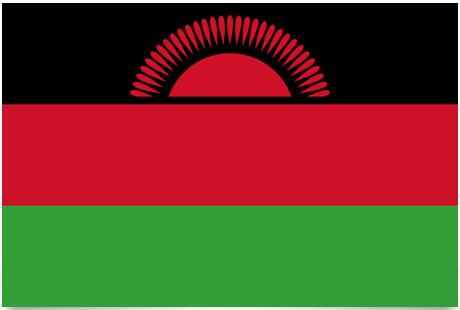Malawi Flag and Meaning
Flag of Malawi

Malawi Flag Meaning
Malawi National Flag, The Flag was officially adopted in 1964. As in many countries in Africa and Asia, Malawi’s flag is based on a political movement’s flag, here the flag adopted by the Malawi Congress Party in 1953.
In 1964, the rising sun was added, symbolizing the dawn and hope of freedom for all of Africa. The black color stands for Africa, the red for the blood shed in the struggle for freedom, and the green for Malawi’s fields and forests.
In 2010, President Bingu wa Mutarika (1934-2012) modified the flag to replace the red and black stripes and the rising sun was replaced by a bright white sun in the middle of the flag. In 2012, Parliament again decided to adopt the original national flag.
Malawi Overview
| Population | 11.3 million |
| Currency | Kwachas |
| Area | 118.480 km² |
| Capital city | Lilongwe |
| Population density | 95.3 residents/km² |
| HDI location | 153 |
The country’s level and climate are very varied. A decisive climatic factor is the Rift fault, which cuts through the country from south to north. Part of this deep fault today is made up of Lake Malawi – formerly called Nyassa – which occupies a fifth of the country’s territory. The rest of the country is made up of plateaus of different heights. The most temperate zone and at the same time the highest is located in the southern part of the country, and at the same time the majority of the population and economic activity – predominantly agriculture – is concentrated. The lower lying zones are dependent on the amount of rain covered by savannah, forest or rainforest. Soil depletion and erosion are among the country’s most serious environmental problems. In early 1998, the drought increased the problem of water access.
The People: The Malawians belong to different ethnic groups, all of which belong to the Bantu family. The main ones are: maravi (including nyanjas, chewas, tongas y tumbukas, 58.3%); lomwes (18.4%); yaos (13.2%) and ngoni (6.7%).
Religion: No official religion exists. Christians, 50% (of which 20% are Protestants and 18% Roman Catholic); Muslims (20%). A large part of the population practices traditional rituals, which does not, however, prevent them from declaring themselves as such. Christians or Muslims.
Languages: English and Chichewa (official languages). Other ethnic groups use other bantu languages.
Political parties: United Democratic Front (UDF), Aliance for Progress (AFP), Party for the Congress of Malawi (PCM).
Social Organizations: Malawi Congress Professional Country Organization.
Official Name: Republic of Malawi
Administrative subdivision: 24 districts
Capital: Lilongwe, 866,000 in (2008).
Other important cities: Blantyre, 518,800 residents, Mzuzu, 94,400 residents (2000).
Government: Republic with Presidential Reign. Peter Mutharika has been President since May 2014. One Chamber Legislative Assembly: National Assembly with 193 members.
National Day: July 6 (Independence, 1964)
Armed Forces: 5,000 Soldiers (2003)
Paramilitary forces: 1,500 (elite police forces)













































